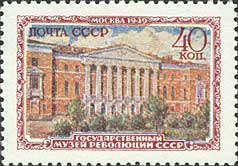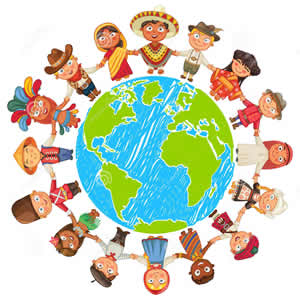Stamp: State Museum of Revolution (Soviet Union, USSR 1950)
State Museum of Revolution (Soviet Union, USSR 1950)
28 March (Soviet Union, USSR ) within release Moscow museums goes into circulation Stamp State Museum of Revolution face value 40 Russian kopek
| Stamp State Museum of Revolution in catalogues | |
|---|---|
| Michel: | Mi:SU 1456 |
Stamp is horizontal format.
Also in the issue Moscow museums:
- Stamp - State Historical Museum face value 40;
- Stamp - Timiryazev State Museum of Biology face value 40;
- Stamp - Zoological Museum of Moscow State University face value 40;
- Stamp - Polytechnic Museum face value 40;
- Stamp - State Tretyakov Gallery face value 40;
- Stamp - State Museum of Oriental Cultures face value 40;
- Stamp - State Museum of Revolution face value 40;
- Stamp - Pushkin State Museum of Fine Arts face value 40;
- Stamp - Central Lenin Museum face value 40;
Stamp State Museum of Revolution it reflects the thematic directions:
A culture is a way of life of a group of people--the behaviors, beliefs, values, and symbols that they accept, generally without thinking about them, and that are passed along by communication and imitation from one generation to the next. Culture is symbolic communication. --the behaviors, beliefs, values, and symbols that they accept, generally without thinking about them, and that are passed along by communication and imitation from one generation to the next. Culture is symbolic communication.
Architecture (Latin architectura, from the Greek ἀρχιτέκτων arkhitekton "architect", from ἀρχι- "chief" and τέκτων "builder") is both the process and the product of planning, designing, and constructing buildings and other physical structures. Architectural works, in the material form of buildings, are often perceived as cultural symbols and as works of art. Historical civilizations are often identified with their surviving architectural achievements.
A museum (/mjuːˈziːəm/ mew-ZEE-əm) is an institution dedicated to displaying and/or preserving culturally or scientifically significant objects. Many museums have exhibitions of these objects on public display, and some have private collections that are used by researchers and specialists. Compared to a library, a museum hosts a much wider range of objects and usually focus around a specific theme such as the arts, science, natural history, local history, and other topics. Public museums that host exhibitions and interactive demonstrations are often considered to be tourist attractions, and many museums attract large numbers of visitors from outside their host country, with the most visited museums in the world regularly attracting millions of visitors annually.
A building or edifice is a structure with a roof and walls standing more or less permanently in one place, such as a house or factory. Buildings come in a variety of sizes, shapes and functions, and have been adapted throughout history for a wide number of factors, from building materials available, to weather conditions, to land prices, ground conditions, specific uses and aesthetic reasons. Buildings serve several needs of society – primarily as shelter from weather, security, living space, privacy, to store belongings, and to comfortably live and work. A building as a shelter represents a physical division of the human habitat (a place of comfort and safety) and the outside (a place that at times may be harsh and harmful).




